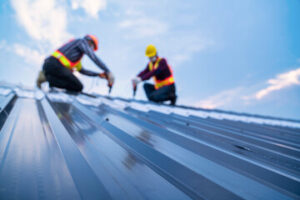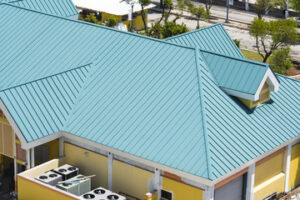A roof must be inspected to ensure it is free from damage and able to repel water. Inspecting the membrane for blisters, tears, and separations is important to prevent leaks and structural problems.

Re-caulking the flashing seals around chimneys, plumbing vent pipes, and skylights can help prevent leaks. Gutter cleaning will help keep debris from clogging them, and adding or improving ventilation helps avoid moisture build-up and rot. Contact Boston Roofing Co for professional help.
A roof inspection is the first step to keeping your home protected. A roofing professional will evaluate the shingles, flashing and gutters. This helps them to identify potential problems with your roof and make timely repairs. They will also check for mildew and other growth that can trap moisture, which can lead to water damage. They will also look at the chimney, vents and skylights for signs of leakage. They will also inspect for shingle deterioration such as curling, cracks and missing granules, which can expose the underlying material to weather elements.
The inspection will include a walk around your house and a visual assessment of the condition of the shingles or shakes from multiple vantage points. The shingles should look even and clean, free of debris such as leaves or branches. Missing shingles can also indicate a serious problem that will need to be addressed promptly.
Cracking or curling shingles expose the interior of your home to water damage, which can result in mold and rot. Ideally, your shingles should be flat and tightly secured to the wood framing of your roof.
A good roof should be able to withstand the elements and the weight of snow. However, if too much snow accumulates on the roof, it may put unnecessary stress on your roofing materials and can lead to structural damage.
A shingle or shake that is deteriorating or showing signs of age can be replaced with new shingles or shakes to restore the integrity of your roof. A roofing professional can advise you about the best shingle or shake for your property, as well as how to replace them.
It’s important to do a thorough inspection of your roof once every two years. A biannual inspection gives you the opportunity to identify potential issues before they become major problems, such as a missing shingle or water spots in your ceiling. This can save you money on repairs and keep your home safe and comfortable for years to come. Before you start a visual inspection of your roof, prepare your ladder and safety gear. A ladder that is tall enough to reach your roof and a pair of binoculars are essential. A notebook or notepad to write down observations and issues is also a good idea.
Clean Your Gutters
Gutters play an important role in directing water away from your roof, so they should be cleaned regularly. Clogged gutters can cause water to overflow and damage your roof, siding, and foundation.
Gutters often get clogged with debris from trees that surround your home. The most common culprits are pine trees, which drop needles year round. Other trees may also fall leaves and branches during the autumn. All of these can clog your gutters and prevent rainwater from draining properly.
Regularly cleaning your gutters is a simple and effective way to prevent expensive damage to your roof. If you’re not comfortable climbing on a ladder, you can hire professional gutter cleaners to do the job for you. However, if you choose to do it yourself, remember to exercise extreme caution. Use a ladder that is stable and wear work gloves to protect your hands. Make sure to wear work goggles to protect your eyes from falling debris and dirt.
Once your gutters are clean, you should flush them with a garden hose to ensure that they’re draining properly. You should also comb through the gutters and remove any debris from the shingles, such as loose granules or pine needles.
Another part of roof maintenance is to trim back overhanging tree branches that may be threatening your roof during storms. Keeping branches 6-10 feet away from your roof reduces the risk of physical damage to your shingles, and helps prevent excessive shade that fosters moss growth.
Whether you’re a do-it-yourselfer or a hiring professional, regular inspections, cleanings, and treatments can help your roof last for years to come. Inspecting for shingle damage, signs of wear and tear, or potential leaks can be done easily with a pair of binoculars. Gutter cleanings can be done with a ladder and a gutter scoop or a small gardening shovel. And don’t forget to brush off your tree branches to prevent rust from forming on the open valley metal in your roof. If rust forms, you can use a wire brush to remove it and then repaint the metal with a high-quality primer and paint.
Trim Your Trees
Tree limbs can fall on your roof during heavy storms, damaging the shingles and causing leaks. Regularly trimming trees around your home will prevent limbs from hanging over the roof and prevent leaves from piling up on the shingles, absorbing moisture that can cause wood rot and algae build-up. It is also a good idea to have a professional inspect your roof after severe weather and regularly throughout the year to ensure that it is in good condition.
The first thing to do when pruning a tree is to cut out any dead branches or branches that have been damaged. Next, you should remove any limbs that are growing into the roof or are at a wonky angle. It is important to keep in mind that removing too much at one time can damage the tree. A general rule of thumb is to cut back to the small lip of bark called the stem collar. This is where the branch attaches to the trunk, and you should make a precise cut.
It is best to trim deciduous trees in late winter or early spring, while evergreens can be trimmed any time of year. It is a good idea to mark the areas where you want to cut with pieces of string, so you can remember to cut those places the following year. Finally, you will want to cut out any limbs that are competing with the dominant leader stem of the tree.
It is important to remember that pruning the wrong way can kill your tree, and one incorrect cut will not immediately harm it, but it can lead to the death of the entire tree. If you are not experienced in pruning, it is a good idea to hire a professional to do the job.
Replace Your Caulk
If the caulking around vent pipes, chimneys, roof flashings, and other structures shows signs of cracking, loosening or deterioration, it should be replaced immediately. Caulking is a flexible sealant that helps prevent water leaks from entering the structure. It also keeps rain and snow from pooling on the roof surface, which could lead to mold or algae growth. It’s important to address these minor problems right away to avoid them from escalating into major issues that may cost thousands of dollars to repair.
Whether you’re tackling the job yourself or hiring a professional, it’s critical to make sure that you’re using the best tools and techniques to get the most out of your caulking work. Before beginning any caulking, read all manufacturer’s instructions carefully. You can use commercial caulk removers or a homemade preparation to soften the old caulk and prepare the area for replacement. It’s recommended to ventilate the work area well as these preparations can produce noxious fumes during the softening process.
Once the caulk is softened, you can remove it using a putty knife or caulk removal tool. It’s important to clean off any remnants of the previous sealant and scrub the surrounding areas with a wire brush to loosen any embedded gravel or debris. You can then wipe the area down with a wet cloth to ensure that it’s completely dry before applying the new caulk.
Lastly, you should inspect all the penetrations on your roof, including skylights and vent pipes. The metal conductor cable for the electrical system should be secure to the roof decking and not dragged or slammed against the roofing membrane, which can cause damage. You should also check that the flashings and sealants are intact at these points.
Regularly addressing these simple maintenance tasks can help you extend the life of your roofing. If you notice that any of these tasks are beyond your skill set, or if the damage you find is serious and in need of immediate repairs, we encourage you to contact us for a free inspection. Our team can perform the necessary preventative maintenance, clear debris from your roof, clean gutters, replace shingles and other components, and perform other services that can extend the life of your facility’s roof.

